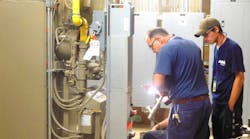Latest from Green
Sponsored
Everyone’s talking about infrastructure these days. And while we can all agree on the imperative need to fix the aging infrastructure across the country, we can’t seem to agree on how to pay for it. For public buildings that need large investments to maintain and repair heating, cooling, plumbing and energy systems, there is a solution — energy performance contracting, which gives public entities the opportunity to finance an energy-efficiency project without upfront costs.
The Connellsville Area School District covers 250 square miles of rural southwestern Pennsylvania and currently has about 4,300 students and 550 employees. In order to reduce its energy and operating costs, it entered into an Energy Performance Contracting program with facility solutions provider ABM (www.abm.com), which developed a customized solution to save the school district an estimated $26.4 million over a 15-year period.
The school district is using the project to help cut operational costs without sacrificing educational opportunities, as part of a three-year strategic financial recovery plan. District officials plan to use the savings to finance educational and technological initiatives across the school district.
“We have operational issues across the board, but for us, the selling point of the project is the educational benefit to our students," explained Philip Martell, superintendent of the Connellsville Area School District. "This partnership allows us to upgrade not only the facilities and security in our building but also the technology. This project gives us the stability to move ahead with an educational component that a lot of public education institutions cannot due to funding cuts."
Earlier this year, the Connellsville Area School District consolidated its eight elementary schools into four, in an effort to align its operational budget with enrollment and improve its students' learning environment. To achieve the estimated cost savings, infrastructure upgrades are needed for multiple facilities in the district, including four elementary schools, Connellsville Area High School, Connellsville Area Middle School and the Connellsville Area Career and Technology Center.
ABM, a 108-year-old company with more than 130,000 employees in more than 350 locations nationwide and in various international locations, developed its energy performance contracting program (www.abm.com/energy/performance-contracting) in the 1980s through its Linc Service Network. Its use was sporadic around the country until the turn of the 21st century, where it began to take off in some regions, such as Pennsylvania.
The EPC is a financial solution that meets clients' technical facility needs and sustainability goals. It drives costs out of clients' operating budgets and allows savings to be reallocated to fund educational and capital expenses.
“I'm looking to help those organizations that really want to affect change within their infrastructure,” said Richard Phelps, ABM’s general manager of building and energy solutions. “In the public sector marketplace, constituents aren't interested in tax increases. As a result, those public organizations, whose infrastructure has aged significantly, have a limited funding stream to help them to address those infrastructural needs.”
That’s when an EPC program such as ABM’s can be beneficial to schools, police and fire department facilities, city and county government buildings, and correctional facilities. “Our job is to execute the client’s vision, without any change orders, and provide a guaranteed outcome with guaranteed savings while minimizing the risk to our clients.”
ABM’s program starts with a conceptual overview with all the decision-makers present and some baseline information that is used to benchmark the client against its peers. This information gives both ABM and the client an idea of the savings opportunities, and includes engineering consultation and building walk-throughs.
ABM gathers information post-project, compares it to the baseline, and verifies that the client is seeing the savings guaranteed to them.
At that point, ABM either qualifies or disqualifies the client for the EPC program. “If the needs are great but the savings are not significant, then there isn't going to be much to fund those needs,” Phelps explained. “It means they're doing a good job in terms of the way they operate their facilities. In the public sector, it doesn't happen very often.”
Once a client is qualified, they go through the public procurement process, which is used by public entities to purchase goods or services from companies. ABM then performs an investment grade analysis and presents those findings to the client.
“We quantify everything the client wants to get accomplished, as well as some of the things that we identify, which will generate savings for the client,” Phelps noted. “Here's the investments associated with this measure, here are the savings that will be generated from it. The client really coauthors a solution from a technical standpoint as well as from a financial standpoint by selecting the different measures to accomplish its goals. There's always a different blend based on what a specific client's needs are.”
Once a project is completed, the program includes continuous measurement and verification. ABM gathers information post-project, compares it to the baseline, and verifies that the client is seeing the savings guaranteed to them. “In the event there is a shortfall, ABM is contractually obligated to make the client whole,” he said.
Coordination is key
Work on the Connellsville Area School District began in July 2017 and is being completed in stages so as not to disrupt students and maintenance staff during the school year. The entire project is scheduled for completion in October 2018.
“It was a large coordinated project between district staff and the ABM team because, as the buildings closed at the end of the 2016-2017 school year, we had to make sure that a number of improvements had been made when they opened up in the fall while minimizing the disruption on the maintenance staff to get those buildings ready,” Phelps said.
He notes that ABM crews are working on direct digital control work during the winter but will add more crews to replace rooftop units with energy recovery units when the schools are closed for the summer. “Summer is a big timeframe for when we're able to get a lot of that work done,” Phelps said. “Usually, we have anywhere from two to three crews — two to four guys per crew — working in the school district. It's kind of light right now but will pick back up here in the summer.”
For the Connellsville project, ABM’s scope of work includes the installation of Lochinvar gas-fired water heaters and commercial boilers; AAON rooftop units and energy recovery ventilators; National Resource Management CoolTrol controls for freezers and coolers’ an open BACnet system-wide server to integrate newly installed Tridium Jaces and Johnson Controls field controllers/end devices; a TEL control system for kitchen hood variable air volume controls; ion generators from Global Plasma Solutions; Raise Energy’s Restore1030 refrigerant treatment; Sloan Valve toilets, urinals and flush valves; Neoperl aerators; and Pedal Valve’s foot pedal valves for hands-free access to water.
ABM also is replacing building envelope weather-stripping and caulking to reduce air leakage, adding LED lighting, installing roofing overlays and retro-commissioning other systems that are not being replaced.
“The biggest challenge was the coordination of the consolidation of those buildings — making sure we were out of the way as they moved property, desks and equipment from one closed building into another,” Phelps explained. “Sometimes we had to change our strategy based on the consolidation and whatever other building issues the district was experiencing at the time."
Along with upgrading the school district's infrastructure, the solution is expected to produce enough general fund savings to purchase each student a Chromebook laptop computer, upgrade televisions, install SMART Boards in classrooms, and upgrade the wireless internet network throughout each of the district's buildings.
"Ultimately, the goal of our partnership with ABM is to provide educational opportunities for our students and staff, and help us meet our buildings' needs to create an environment conducive to learning," Martell said. "ABM's creative solution will help us do that."
Providing energy performance contracting services fulfills a vital need in local communities to replace aging infrastructure in public buildings, especially K-12 schools.
“The challenges facing schools in Pennsylvania, and probably nationally, are just tremendous,” Phelps noted. “Districts have made cuts but there really is no more fat to cut in their budgets. It's creating a situation whereby districts need to be creative in how they look to the future. The EPC program is a solution specifically designed to address those challenges.”

Kelly L. Faloon | Freelance Writer/Editor
Kelly L. Faloon is a contributing editor and writer to Contractor, Contracting Business magazine and HPAC Engineering and principal of Faloon Editorial Services. The former editor of Plumbing & Mechanical magazine, Faloon has more than 26 years of experience in the plumbing and heating industry and more than 35 years in B2B publishing. She started a freelance writing and editing business in 2017, where she has a varied clientele.
Faloon spent 3 1/2 years at Supply House Times before joining the Plumbing & Mechanical staff in 2001. Previously, she spent nearly 10 years at CCH/Wolters Kluwer, a publishing firm specializing in business and tax law, where she wore many hats — proofreader, writer/editor for a daily tax publication, and Internal Revenue Code editor.
A native of Michigan’s northern Lower Peninsula, Faloon is a journalism graduate of Michigan State University. You can reach her at [email protected].


